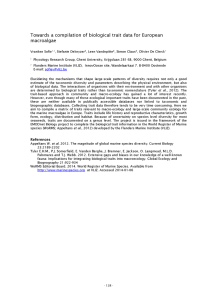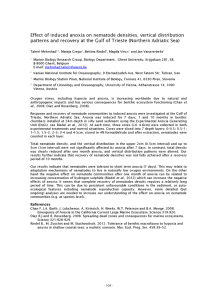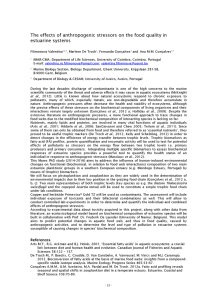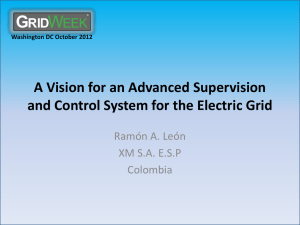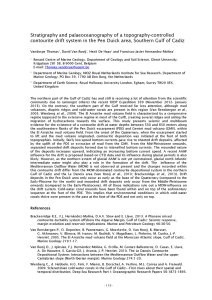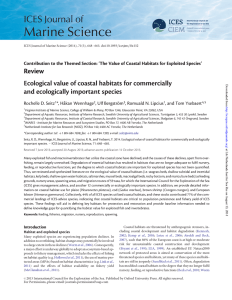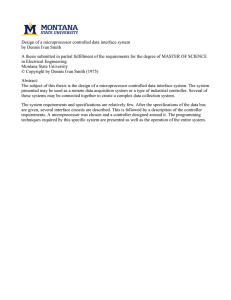ô o ja jd ^ H a j P
advertisement
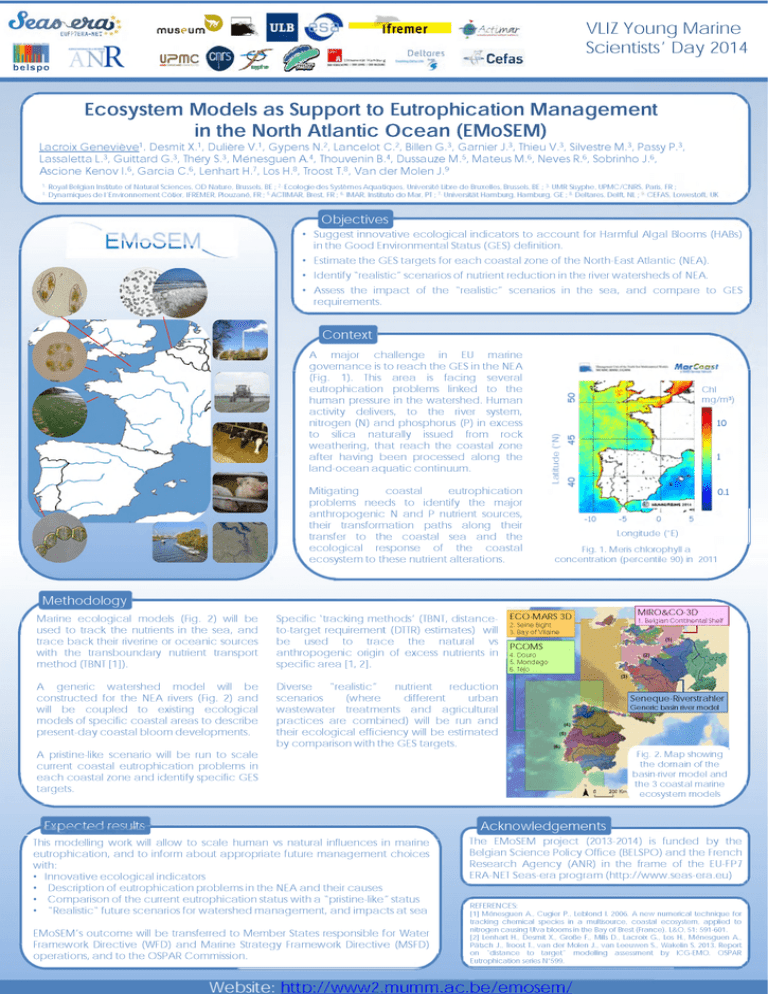
ô o ja jd ^ H a j P m museum E U F P 7 E R A -N E T Deltores upmc bel spo Ifremer U im niW Htmkurf VLIZ Y o un g M a rin e Scientists' D ay 2014 ŸActLHW -Cefas Ecosystem Models as Support to Eutrophication M anagem ent in the North Atlantic O cean (EMoSEM) La croix G e n e v iè v e 1. D esm it X.1, D ulière V .1, G yp e n s N.2, L a n c e lo t C .2, Billen G .3, G a rn ie r J.3, Thieu V.3, Silvestre M .3, Passy P.3, La ssaletta L.3, G u itta rd G .3, Théry S.3, M é n e s g u e n A .4, T hou ven in B.4, Dussauze M .5, M a te u s M .6, N eves R.6, S obrinho J.6, A s c io n e K en ov I.6, G a rc ia C .6, L e n h a rt H.7, Los H.8, Troost T.8, V a n d e r M o le n J.9 ^ Royal Belgian Institute o f Natural Sciences, OD Nature, Brussels, BE ; 2■Ecologie des Systèmes Aquatiques, Université Libre d e Bruxelles, Brussels, BE ; 3 UMR Sisyphe, UPMC/CNRS, Paris, FR ; ^^^^ynam iquesd^Environnem en^ôtieU R 3EM ER D >louza^ Objectives Suggest Innovative e c o lo g ic a l Indicators to a c c o u n t for Harmful Algal Blooms (HABs) In th e G o o d Environm ental Status (GES) definition. I V lU O L _ l . Estimate the GES targets for e a c h coastal zone of the North East Atlantic (NEA). Identify "realistic" scenarios o f nutrient re d u ctio n In the river w atersheds of NEA. í*v% i Assess th e Im p a c t o f th e "realistic" scenarios In the sea, a n d c o m p a re to GES requirem ents. r«w ^ Context A m ajor ch a lle n g e In EU m arine g o v e rn a n c e Is to re a ch the GES In th e NEA (Fig. 1). This a re a Is fa cin g several e u tro p h ica tio n problem s linked to the hum an pressure In the w atershed. Human a ctivity delivers, to the river system, nitrogen (N) a n d phosphorus (P) In excess to silica naturally Issued from rock w e a th e rin g , th a t re a ch the coa stal zone a fte r having b e e n processed alon g the la n d -o c e a n a q u a tic co n tin u u m . M itigating coastal eu tro p h ica tio n problem s needs to Identify the m ajor a n th ro p o g e n ic N an d P nutrient sources, their transform ation paths alon g their transfer to the coa stal sea a n d the e c o lo g ic a l response o f the coastal ecosystem to these nutrient alterations. M o rC n o s t 1t > L '%<■ C hi m g /r r b 10 .......... A. 0) V , c. • ‘ TJ \Y v i f *” .V 0.1 (C MUMtmWH ?»11 I s L o n g itu d e (°E) Fig. 1. M erls c h lo ro p h y ll a c o n c e n tr a tio n ( p e rc e n tile 90) In 2011 M ethodology M arine e c o lo g ic a l m odels (Fig. 2) will be used to tra c k the nutrients In the sea, and tra c e b a c k their riverine or o c e a n ic sources w ith th e transb ou nd ary nutrient transport m e th o d (TBNT [1]). S pecific 'tra ckin g m etho ds' (TBNT, dlstanceto -ta rg e t require m en t (DTTR) estimates) will be used to tra c e th e natural vs a n th ro p o g e n ic origin o f excess nutrients In sp e cific a re a [1, 2], A g e n e ric w a te rshe d m od el will be co n stru cte d for the NEA rivers (Fig. 2) a n d will be c o u p le d to existing e co lo g ic a l m odels o f spe cific coastal areas to describe pre sen t-d ay coa stal b lo o m developm ents. Diverse "realistic" nutrient re d u ctio n scenarios (where diffe re nt urban w a s te w a te r treatm ents a n d agricultural p ra ctice s are co m b in e d ) will be run a n d their e c o lo g ic a l e fficie n cy will be estim ated by com p ariso n w ith th e GES targets. 1. B elgia n C o n tin e n ta l Shelf Seine Bight 3. Bay o f V ila in e PCOMS 4. D ouro 5. M o n d e g o 5. Tejo A prlstlne-llke scenario will be run to scale curre nt coa stal e u tro p h ica tio n problem s In e a c h coastal zone a n d Identify spe cific GES targets. Seneque-Riverstrahler G eneric basin river model A /IB Expected S H B a results S H a ------------------------------------------------------------------- V f M IR O & C O -3 D ECO-MARS 3D This m odelling w o rk will allow to scale hum an vs natural Influences In m arine i e u tro p h ica tio n , a n d to Inform a b o u t a p p ro p ria te future m a n a g e m e n t choices with: • Inn ovative e c o lo g ic a l Indicators • Description o f e u tro p h ic a tio n problem s In the NEA a n d their causes • C om parison of the curre nt e u tro p h ic a tio n status w ith a "prlstlne-llke" status • "R ealistic" future scenarios for w a te rshe d m a n a g e m e n t, a n d Im pacts a t sea EMoSEM's o u tc o m e will be transferred to M em b er States responsible for W ater Fram ew ork Directive (WFD) a n d M arine Strategy Fram ework Directive (MSFD) operations, and to the OSPAR Commission. 0 200 Km F ig . 2. M a p s h o w in g th e d o m a in o f th e b a sin -rive r m o d e l a n d th e 3 c o a s ta l m a rin e e c o s y s te m m o d e ls Acknowledgements The EMoSEM p ro je ct (2013-2014) Is fu n d e d by the Belgian Science Policy Office (BELSPO) and the I rench Research Agency (ANR) in the frame of the EU 1117 ERA-NET Seas-era p ro gra m (h ttp ://w w w .se a s-e ra .e u ) REFERENCES: [1] Ménesguen A., Cugier P., Leblond I. 2006. A new numerical technique for tracking chem ical species in a multisource, coastal ecosystem, applied to nitrogen causing Ulva blooms in the Bay o f Brest (France). L&O, 51: 591-601. [2] Lenhart H., Desmit X., Große F., Mills D., Lacroix G., Los H., Ménesguen A., Pätsch J., Troost T., van der Molen J., van Leeuwen S., Wakelin S. 2013. Report on "distance to target" modelling assessment by ICG-EMO. OSPAR Eutrophication series N°599. httD ://w w w 2. m um m .a c.b e /e m o s e m /

